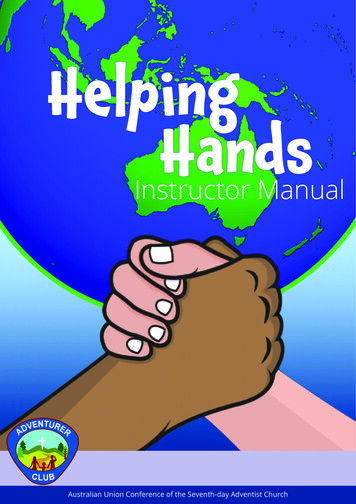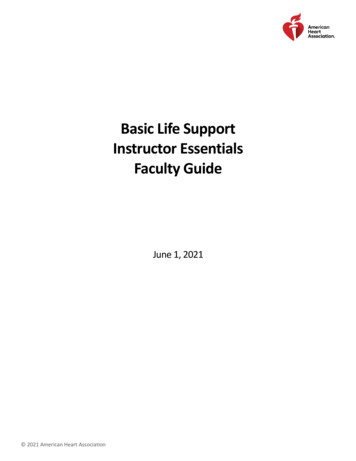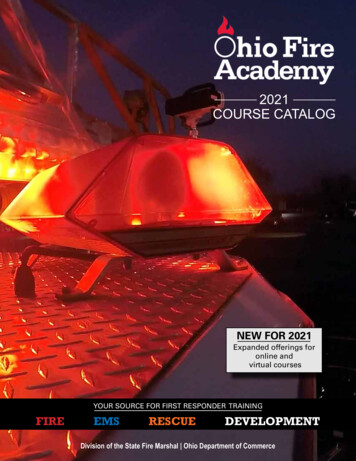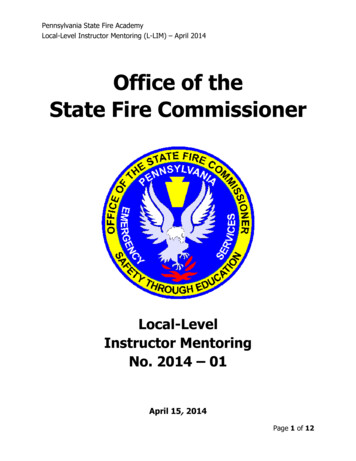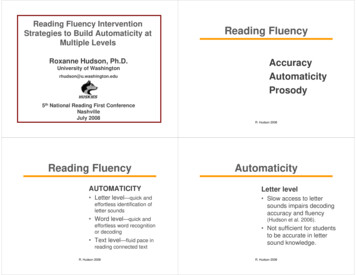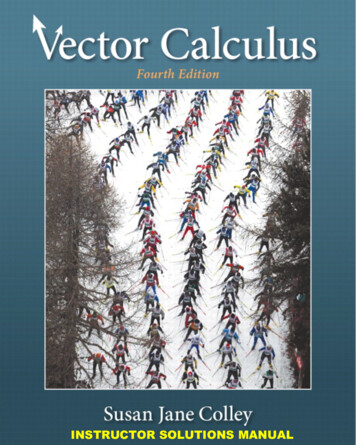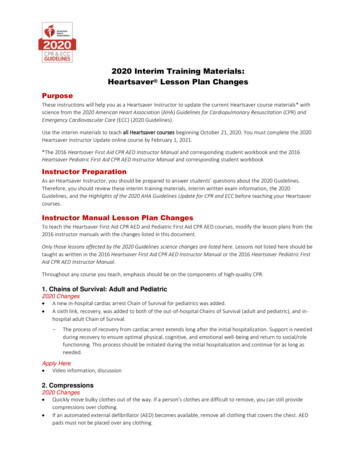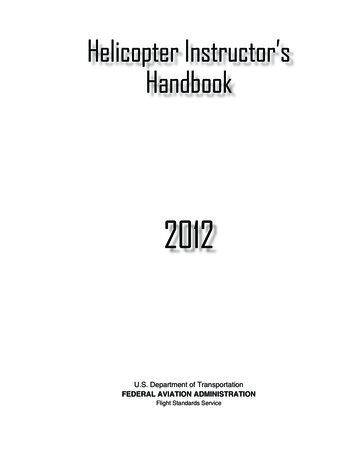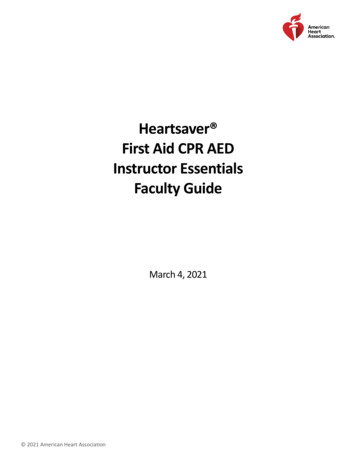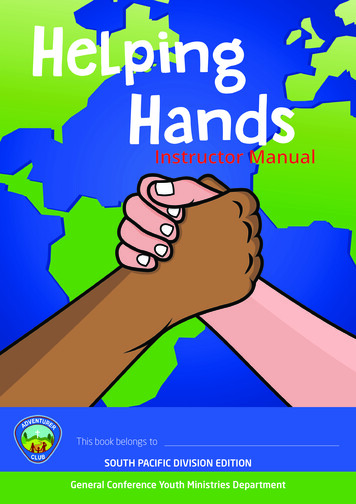
Transcription
Instructor ManualThis book belongs toSOUTH PACIFIC DIVISION EDITIONGeneral Conference Youth Ministries Department
Helping HandsInstructor ManualENTUREVRADCLUBSOUTH PACIFIC DIVISION EDITIONGeneral Conference Youth Ministries Department
Produced by:Magulilo Mwakalonge (ECD)General Conference Youth Ministries DepartmentNak Hyung Kim (NSD)12501 Old Columbia PikeNick Kross (SPD)Silver Spring, MD 20904Peter Bo Bohsen (TED)Tihomir Lazic (TED)Departmental Director: Gary BlanchardTracy Wood (NAD)Associate Youth Director: Pako MokgwaneUdolcy Zukowski (SAD)Associate Youth Director: Andrés J. PeraltaUgochukwu Elems (WAD)Editor-in-Chief: Andrés J. PeraltaVandeon Griffin (NAD)Departmental Advisor: Abner De Los SantosZlatko Musija (TED)Senior Editorial Assistant: Kenia Reyes-de LeónResources:Project Manager: Mark O’FfillContent Contributors: Mark O’FfillTed & Betsy BurgdorffCopy Editor: Mark O’FfillCover & Interior Designer:Jonatan TejelIsaac ChiaAdrian Gutierrez PerezWilbert Hilario (ClicArt)Had Graphic Inc.hadgraphic@gmail.comPhotos by: ShutterstockDivision Correspondents:Gomez, Ada. “Adventist Adventurer Awards.” Adventist Adventurer Awards - Wikibooks.org. North American DivisionClub Ministries, 2014. Web. 26 July 2017. https://en.wikibooks.org/wiki/Adventist Adventurer Awards .Gooch, Jennifer A. Eager Beaver Leader’s Guide with 23Themed Meeting Plans. 3rd ed. Lincoln, Neb.: AdventSource, 2007, 2015. Print.For informationEmail: youth@gc.adventist.orgWebsite: youth.adventist.orgMailing Address:Adventist Youth MinistriesGeneral Conference of Seventh-day Adventist12501 Old Columbia Pike,Silver Spring, MD 20904-6600, USAAl Powell (IAD)Alastair Agbaje (TED)SOUTH PACIFIC DIVISION EDITION:Armando Miranda (NAD)Adapted by SPD Discipleship Youth TeamBenoy Tirkey (SUD)148 Fox Valley Road, WahroongaBusi Khumalo (SID)NSW 2076, AustraliaCarlos Campitelli (SAD)Gennady Kasap (ESD)Ron Genebago (SSD)Jonatan Tejel (EUD)Director/Specialist: Nick KrossDept. Assistant: Diane Samani EkeEmail: youth@adventist.org.auWebsite: youth.adventistchurch.com
Dear Adventurers, Parents, and Leaders,Thank you for being a part of our newly released Adventurer Curriculum. We haveremastered, reengineered, and at times started over to make sure that this newcurriculum is fun, uplifting, appropriate for each age level, and most importantly, Jesuscentered. We wanted to build a curriculum that can be done with a small group, largegroup, family and children, Children’s ministry group, even Bible School group!We have used several criteria in building this curriculum. We worked with Adventisteducators and youth leaders to make sure we had the best resources available for ourAdventurers. First, we have used Bloom’s taxonomy, a broad ranging methodologyespecially appropriate for 7 year olds and up, that helps us ask the children to do thingsthat they are truly developmentally capable of doing. For example, we ask Little Lambsto listen to a story, while we ask 8 and 9 year olds to read age-appropriate stories. Inaddition, we have used a multi-modal learning philosophy, meaning that we realisethat Adventurers learn in different ways. Thus, we have requirements that appeal tochildren who learn best through listening, playing, drawing, singing, organising, moving,and so-on. We also filtered our requirements through developmental filters. Spiritualstages of development, originally developed by Dr. John W. Fowler, have been wellexplained and demonstrated in Youth Ministry by Adventist Youth Innovator Steve Caseof Involve Youth.Adventurers - each lesson is meant to be mostly hands-on. That means most of thetime you will be actively doing something to learn about the topic. Sometimes, you’llhave to take notes, or check a box (to remember what you did), but most of the timeyou will be jumping, running, crafting, drawing, exercising, singing, praying, or readingsomething! In many cases, your adult caregivers, whether they be your parents,grandparents, guardians, or favourite neighbour, can help you accomplish the “jobs.”Help them feel involved and be sure to always say thank you!Parents - we value the time you have invested in Adventurers. Many of you aredoubling as leaders for Adventurers. We thank you. We have created a curriculumthat is safe yet adventurous, varied, but specific in its Christ-centred goal. We hope thechildren will bring home new found truths they can put into action about “My Self, MyGod, My Family, and My World.” Please have your Adventurer share their experienceswith you by showing you the pages they worked through (and the games/stories theylearned along the way). Know that a lot of it is experiential so they won’t write a lot.They will instead experience a great deal.Helping Hands Instructor Manual 5
Leaders - Before the student worksheet pages come a variety of ‘big picture’ helpsto guide you as you create a safe environment for your group of Adventurers.Developmental stages, working with special needs children in your unit, and muchmore is included here. In addition, this curriculum has a huge number of teachingideas in the back pages of this booklet. These teaching suggestions are hands-on fieldtested ideas that you can use with a little bit of prep and a few tools. We have tried tothink of things that can be done with few resources, limited spaces, and limited budget.However, your club is different from any other, so please feel free to adapt the ideas tomeet the needs of your class. At the front of the book are additional ideas on how toformat meetings and unit time so that within about 15 meetings, the class requirementsare done and you can award your Adventurers with their class pin and awards. Ofcourse, that means that you may also have other meetings that are primarily field trips,group awards, or other activities -- that’s GREAT!The young Adventurer, is eligible for a special pin that matches the name and imagelocated on the book cover. There are a total of six years worth of classes, each one ageappropriate. The first, Little Lamb is for 4 year olds, next are the Early Birds for 5 yearolds, Busy Bee for 6 year olds, Sunbeam for 7 year olds, Builder for 8 year olds, andHelping Hands for the 9 year olds. Many kids will turn from one age to the next duringthe Adventurer year but should work to complete that years class. Usually there are 1025 meetings in an Adventurer year, a number based on the clubs availability to meet.Patches (called awards) and pins (for finishing the classwork in this book) forAdventurer ministry are available through your local Youth Department or AdventistBook Centre. Division Youth Teams usually take orders from local conferences/missionsand then at the World Headquarters in Washington D.C., the order list to brought myoffice. We fulfill the orders and send thousands of patches back home to your Divisionfor you to distribute to your deserving kids!Thanks for joining us in the journey!Andrés J. Peralta6 Helping Hands Instructor ManualAssociate Youth Director
Adventurer Club HistoryThe history of Adventurers started back in 1917 when the Primary Reading Course wasintroduced. This certificate eventually became part of the class requirements. In 1924the Sunbeam class was taught in a second-grade classroom and a pin was awarded forcompleting the requirements. The awarding of the Busy Bee pin first appeared in 1928as part of the commencement exercises at school, and by 1929 the term “InvestitureService” was used to describe the event where they awarded certificates and pins. TheBusy Bee Pledge and Law also first appeared in 1929.The names used for this age group have varied over time and location and includedPreparatory classes, Pre-Juniors, Pre-Friends, Pre-JMV, Pre-AJY, Pre-Pathfinders,Achievement classes, and Adventurers.By 1933, this group was known as “Preparatory Members.” The two predominant classestaught on the West Coast of the United States were Busy Bee and Helping Hand, whileto the East they were known as Sunbeam and Builder. All of these classes used thesame Pledge and Law, with only slight differences in the other requirements.By 1938 the term “Progressive Class Work” was used when referring to all the classesfrom Busy Bee up to Master Comrade.In 1940 the General Conference outlined two Missionary Volunteer Progressive Classesthat were below the Friend class. They were Sunbeams and Builders. They had simplecelluloid pins, and where neckerchiefs were desired, tan was used for the Sunbeamsand jade green for the Builders.Because of so many other names being used for these classes, both in the U.S. andoverseas, such as “Upstreamer,” “Junior Light Bearers,” “Sunshine Club,” and “GoldenRule,” the MV committee voted on June 10, 1946 that the Pre-Junior classes be namedBusy Bee, Sunbeam, Builder, and Helping Hand.In 1953 there was first seen a pre-Pathfinder Adventurers group, and by 1954Adventurer camps started up in different conferences for boys and girls age 9, and lateron for both 8- and 9-year-olds.Helping Hands Instructor Manual 7
The name Adventurers was used again in 1963 for a pre-Pathfinder group, this time atthe Pioneer Memorial Church at Andrews University.In 1974 in the Washington Conference, for the previous 5 years a group called Beaversfor the 6 to 9-year-old kids was going on. They had their own uniforms, consisting ofyellow shirts or blouses and brown trousers or skirts.By 1976 the Youth Leaders’ Handbook mentioned the newly revised pre-JMV Classes,and by 1979 in the NAD, “pupils in grades one to four are designated as Adventurers.”The General Conference Committee minutes of 1985 mentions the Adventurer ClassRequirements. The SDA Church Manual of 1986 again says, “Pupils in grades one tofour are designated as Adventurers,” and by 1989 the General Conference Committeevoted to approve organising the Adventurer Club as part of the Pathfinder programand voted in the official Adventurer Emblem.In 1990 several Conferences tried out a pilot program of the new Adventurer Clubmaterials from the GC which included their own navy blue and white uniforms, theirown award patches (triangle in shape), and their own club structure. The followingyear Norman Middag introduced the new Adventurer Club program to those whoattended the Children’s Ministries Convention held at Cohutta Springs, GA.In 1999 the GC Annual Council recommended that a new section, Adventurer club, beadded to the Church Manual.8 Helping Hands Instructor Manual
Helping Hands ChecklistName:Date Started:Basic Requirements1. Repeat from memory and accept theAdventurer Pledgea. Demonstrate real life situationswhere the Pledge and Law helpyou to respond to situations ina Christ-like way. Illustrate or actout those situations2. Complete the Reading IV award3. Complete the Hands of Service awardMy God[choose at least one section]1. God’s Plan to Save Mea. Create a story chart or lap-bookshowing the order in which theseevents took place: Paul, Martin Luther, Ellen White & Yourself.b. Plan and act out a skit or write anews story about one of those storiesabove, to show how a person is aspiritual hero.2. God’s Message to Mea. Complete the Bible IV award.3. God’s Power in My Lifea. Spend regular quiet time with Jesusto talk with Him and learn aboutHim. Keep a record.b. Ask three people (other than family)why they decided to give their lifeto Jesus OR earn the Steps to Jesusaward.c.Complete the My Church award.b. Demonstrate and share your talentby earning one of the Adventurerawards that allow expressions ofpersonal talents.2. I Can Make Wise Choicesa. Learn the steps of good decisionmaking. Explain or demonstrate howto use them to solve two real-lifeproblems.Date Completed:Instructor ChecklistBasic Requirements1.a.2.3.My God1.a.3. I Can Care for My Body a. Complete the Hygiene award. [choose at least one section] b.1. I Have a Family2.a. Make a family flag or banner.a.3.b. Complete the My Picture Book award.a.2. Families Care for Each Otherb.a. Help plan a special family worship,c.My Familyfamily night or family outing. Reportwhat you did to your group.3. My Family Helps Me Care for Myselfa. Complete the Cooperation award.My World[choose at least one section]1. The World of Friendsa. Complete the Early Adventist Pioneeraward.2. The World of Other Peoplea. Complete the Country Fun award.3. The World of Naturea. Complete two Nature awards notpreviously earned.My Self1.a.b.2.a.3.a.My Family1.a.b.2.a.3.a.My WorldMy Self[choose at least one section]1. I Am Speciala. List some special interests andabilities God has given you.1.a.2.a.3.a.Helping Hands Instructor Manual 9
INTRODUCTION“Let the little children come to me, and do not hinder them, for thekingdom of heaven belongs to such as these.”–Matthew 19:14 (NIV)This passage is often illustrated with a group of angelic children sitting attentively atJesus’ feet. Perhaps this was the first picture that popped into your mind when youagreed to lead out with Helping Hands. However, now that you’ve had time to thinkabout it, the picture may have quickly changed to a group of noisy 9 year olds runningaround the room or huddled in the corner planning their next conquest. Hopefully thereality will be somewhere in between these two pictures!This guide was developed to assist parents and Helping Hand level leaders who wantto work with children as they develop physically and spiritually. The Helping Hand classcan be used as part of the Adventurer Club in your church or by a group of parents whowant to use a curriculum to assist them in teaching their children skills and values.All Helping Hand activities should be fun and kid-centered. Remember that childrenof this age look to adults to set the pace of the meetings and model how they shouldrespond to situations. So . . . take a deep breath, say a prayer, and keep your sense ofhumour. Your adventures with Helping Hands are about to begin!10 Helping Hands Instructor Manual
SECTION1The Helping Hands LevelThis section contains an overview of the HelpingHand level. You’ll get a quick look at how HelpingHands fit into Adventurer Club Ministries, the goals,Pledge, Law, song, and more!Helping Hands Instructor Manual 11
NewAdventurer nistryFamilyFocusedMinistryCLUB12 Helping Hands Instructor Manual
Helping Hands Goals01Demonstrate God’s love for children.02Promote the values expressed in the AdventurerPledge and Law.03Create an environment where all childrencan contribute.04Encourage children to have fun.Adventurer PledgeBecause Jesus loves me,I will always do my best.Adventurer LawJesus can help me to: Be obedientBe pureBe trueBe kindBe respectful Be attentiveBe helpfulBe cheerfulBe thoughtfulBe reverentAdventurer Song*(Wanderson Paiva)We are joyful and faithful adventurersAlways trusting our friend, Jesus Christ;And we know that our lives are a blessingWhen we shine like a beacon of light.We can see all the beauty around usFrom the hand of a great living GodIf we live to proclaim His creationWe will see all the wonders of love.*Both Adventurer songs have been approved by the GeneralConference (GC) Youth Ministries department. Sheet music & resourcesare available via the GC Youth website.Adventurer Song*We are AdventurersAt home, at school, at playWe are AdventurersWe’re learning every dayTo be honest, kind, and trueTo be like Jesus through and throughWe are Adventurers!Helping Hands Instructor Manual 13
The Helping Hands ClassOne of your responsibilities as Adventurer parents and staff is to encourage the physical,mental, and spiritual development of each child. The Adventurer curriculum was created toassist you with this responsibility. The Helping Hand class is organised into five areas: Basic,My God, My Self, My Family, and My World. Additionally, with lots of fun and educationalawards the children can earn.Each child is required to complete all Basic Requirements and at least one requirement fromeach of the remaining four areas (My God, My Self, My Family, and My World). At the endof the Adventurer year, each child who complete these class requirements will receive theHelping Hand pin during the Investiture Service.It is very important for Adventurer staff to understand that not all Helping Hands will be atthe same developmental level or have the same physical abilities, so you’ll need to be flexiblein how the children complete these requirements. It is up to you to interpret how the childrenfulfill these requirements. For example, not all children will be able to memorise or read Bibleverses. Instead, you can explain the verse to the child and then have the child draw a pictureillustrating the verse. A child might not be able to grip a paintbrush but, instead, could dip alarge sponge into paint and decorate a sheet of paper. Again, flexibility and creativity are thekeys to ensuring the success of each Helping Hand.14 Helping Hands Instructor Manual
Adventurer AwardsHelping Hands patches are called awards. There are lots of awards and each one is designedto encourage your Adventurer to explore, learn, and play. Once the Adventurer has completedall the required activities for an individual award he or she can receive that patch.Many awards are completed as part of the Helping Hands class but it is encouraged for timesto be scheduled for awards to be completed as a club.It is important to note that the awards have levels that correspond with the Adventurer levels.When you are selecting an award to complete, make sure that you choose age-appropriateawards.When working on awards it is up to the leader to adapt the requirements to the club andchildren’s needs. For example, an award may require the child to play an action game usinga community helper’s skills. As parent or leader you might choose to watch a video or visit acommunity helper.It is also up to you to decide when a child has met the intent of the award. Remember thatnot all children will be capable of completing all award requirements as written. It is moreimportant that the children try new things and have fun than compete with each other toreceive the most awards or become frustrated by requirements that are beyond their abilities.Flexibility on your part will make the experience more enjoyable and positive for both childrenand parents!Helping Hand age children like immediate rewards but are able tounderstand delayed recognition better than the younger agegroups. When they complete an award you could give thema picture of the award or write on their record card oractivity book and let them know they will receive thepatch at the Investiture Service.Helping Hands Instructor Manual 15
16 Helping Hands Instructor Manual
SECTION2Characteristics of Helping HandsThis section gives you and your staff a quickoverview of what to expect and what not to expectfrom Helping Hands.Helping Hands Instructor Manual 17
What You Need to KnowAbout Helping HandsIn the book Child Guidance (Review and Herald, 1954), Ellen White encourages parents tounderstand the developmental needs of their children. This section helps you with just that —understanding the physical, cognitive, and social characteristics of Helping Hands. Rememberthat children develop at their own pace, so some children in your club may not have reachedthese markers, and others will have passed them. Also, abilities that children don’t have at thebeginning of the Adventurer year, they may obtain later in the year. Helping Hands are quicklygrowing and learning. Make sure you focus on the specific needs of each child and not thestages.18 Helping Hands Instructor Manual
Physical Characteristics Have high energy levels and may play until exhausted. Girls are usually ahead of boys in physical development. Experience growth spurts and may be unsure about their bodies. May complain of stomachaches, headaches, and leg pains causedby growing pains and anxiety. Have improved fine motor skill development. May have poor posture and squirm a lot as they adjust to bodychanges.Cognitive Characteristics Can think independently but care what peers think. Are developing a strong ethical sense of right and wrong. Can understand cause and effect. Value being trusted. Are concrete learners. Enjoy memorising but may not understand the meaning behind what they memorise. Like to organise and categorise information and objects. Are frequently anxious and stressed. They want to succeed. Can prioritise and set goals.Helping Hands Instructor Manual 19
Social Characteristics Need lots of opportunities for success. Appreciate behaviour and new tasks being modeled so they know what to expect and howto do it. Benefit from competition being minimised. Do well in a cheerful and fun environment where they are encouraged to try new things. Need to follow the rules. Benefit from schedules and routines. Learn by doing: acting in plays, writing stories, building things, painting, and playing games. Like to make choices. May need rest breaks or high energy activities followed by low energy activities. Like to collect things.Spiritual CharacteristicsJames Fowler, a Christian counsellor, researcher, and specialist in children’s development, hasidentified seven stages in the development of faith; three of which are closely associated withand parallel cognitive and psychological development in childhood.These stages are:Primal Faith (ages 0-2)1-Intuitive-Protective Faith (ages 3-5)2-Mythic-Literal Faith (ages 6-11)3-Synthetic-Conventional Faith (age 11-Adolescence)4-*Individuative-Reflective Faith5-*Conjunctive Faith6-*Universalising FaithStage 0 “Primal Faith” is the beginning steps of faith within the arms of their parents. Stages3-6 are the faith stages of Pathfinders and adults. He has done research and sees that manyindividuals, even adults, may never develop stages 4-6 unless intentional ongoing spiritualdevelopment is a chosen part of their ongoing deepening relationship with God. In Adventurerswe are working with children who are learning to experience God through stages 1 & 2.20 Helping Hands Instructor Manual
Stage 1 (Little Lambs andEarly Birds) Shared experiences - kids love having a community to share their spiritual learning with. Parental - parents are involved in the Adventurer experiences and provide a lot of thespiritual modeling Love & Security - God is real because of the love and security supplied by caregivers, suchas parents and Adventurer leaders Concrete Meaning - Truth about the Bible makes sense because of things they can touchand Bible stories they can relate to. They are unable to think abstractly and are generallyunable to see the world from anyone else’s perspective. Experienced Traditions - opening exercises that are always the same, the Adventurer Pledgeand Law that are learned and repeated each session throughout the years of Adventurersare a part of this experienced tradition. God becomes more real when things arepredictable and they know what to expect from spiritual activities. Faith is not a thoughtout set of ideas, but instead a set of experienced impressions WITH parents and influencers.Stage 2 Mythical-Literal (BusyBees - Helping Hands) Compared - Children at this age are able to start to work out the difference betweenverified facts and things that might be more fantasy or speculation. Trust Circle - Source of religious authority starts to expand past parents and trusted adultsto others in their community like teachers and friends. Religion as their Experience - Kids in this age group have a strong interest in religion. Laterin this stage children begin to have the capacity to understand that others might havedifferent beliefs than them. Duty - following God and his teaching is seen as a duty and honour. Concrete Meaning - By default, children in this age group see that prayer to God isimportant and expected. They believe that good behaviour is rewarded, and bad behaviouris punished. If I am good to God, God will be good to me. Teaching the reality of God’sGRACE beginning at this stage will allow them to further deepen their relationship withJesus as they enter stages 3 & 4. Experienced Traditions Symbol’s Meaning - Symbols of scripture are literal without addedmeaning. Bible stories are powerful and real motivators.Helping Hands Instructor Manual 21
Do’s and Don’ts of DisciplineOne of the best ways to prevent disciplinary problems is to keep Adventurers busy and ontask. The following strategies will help you manage your Adventurers. And remember, you’rethere to help the children and their families learn to love Jesus; therefore, it is important thatyou model love, patience, and a cheerful attitude. You want the Adventurer Club to be a funexperience for everyone, so try to keep your sense of humour and compassion even when anAdventurer’s behaviour is a problem.22 Helping Hands Instructor Manual
DO . . . Have a few short, simple rules and post them. Sample rules: Be kind to others. Use goodmanners. Listen quietly to others. Follow directions. Be positive. Use signals to let the children know when you want their attention. Signals can be justabout anything such as quickly turning a light on and off, turning a flashlight on and off,raising your hand, or using a clicker. Use silence. Stop what you are doing and stay quiet until their focus is back on you. Make eye contact. Often getting a child to look at you is a good way to get her to stop whatshe is doing and focus on you. Use names. If you say an Adventurer’s name followed by a question or instructions, you canusually get him back on track. Stand near an Adventurer to get her back on task. Ask adults to interact with the children. If adults are happily participating in the activities,the Adventurers are more likely to model the adults’ behaviour. Additionally, having adultsinvolved can prevent misbehaviour from escalating.DON’T . . . Embarrass or shame a child in front of others or privately Overreact Lose your temper—no screaming, using threats or nagging Hit or spank Insult a child by saying “you’re stupid” or “you’re useless” Use sarcasm Compare children Label children Demand respect — respect is earned Expect children to behave as adultsHelping Hands Instructor Manual 23
24 Helping Hands Instructor Manual
SECTION3Helping Hands with DisabilitiesLearn how every Helping Hand can fully participatein your club by understanding each child andknowing how to plan inclusive activities.Helping Hands Instructor Manual 25
Including Helping Handswith Disabilities/Special NeedsWhen you learn that a child with a disability will be a member of your club, you mightinitially feel overwhelmed. Don’t worry. Arrange a meeting with the child’s parents/caregiversto discuss the child’s needs and medical issues. Often simple changes to an activity orrequirement are all that is needed. Kids this age with disabilities can generally tell you whenthey require assistance and if they can’t, their parents or guardians can. Remember thatparents or guardians are not looking to you to discredit a diagnosis or to offer a “cure” for acondition; rather they are looking to you to welcome and include their child. Additionally theother children and adults look to you to see how to act, so make sure you treat the child witha disability with the same openness and ease that you show all of the children.DO’S Speak directly to the child, not to the adult. Recognise that a child’s physical disabilities don’t indicate mental disabilities. Ask about the child’s medical or special equipment needs. Explain special equipment to all children to alleviate fears. Take extra care in planning for the safety of the child with special needs. Ensure the meeting facility is handicapped accessible. Ask the child how they would prefer to complete a task. Foster independence. Focus on all children’s strengths. Expect reasonable behaviour from all children. Be flexible.26 Helping Hands Instructor Manual
Planning Inclusive ActivitiesAt times you will need to substitute or change program requirements in order for childrenwith disabilities to participate. This may require some creative thinking on your part.Remember that the point is for the activity to be fun and meaningful for the child. Here aresome ideas to get you started. Instead of requiring the child with a learning disability to memorise Bible verses, let herdraw pictures of the themes of verses: Jesus cares for me today, Jesus comes again, andJesus will take me to Heaven. For the autistic child over-stimulated by others and noise, let him sort coloured buttonsinstead of playing a button game with other children. If a child has a balance problem, provide a bike with training wheels for the bike rodeo. Instead of making a creation story chart, a blind child can make a creation collage, usingsmall plastic animals and other tactile objects. A child with cerebral palsy and poor fine motor skills may not enjoy colouring. Try enlargingthe colouring sheet and taping it to the table so it won’t slip. Large crayons might be easierfor her to use than small crayons. Teach all children to use sign language for the Adventurer Pledge. This will allow a deafchild or a child with a speech impairment to participate. A child with Down syndrome who exhibits delayed speech can act out feelings and have anadult take a picture. Then the child can glue the picture onto construction paper with thehelp of an adult.Helping Hands Instructor Manual 27
ADDITIONAL IDEAS Invite a special education teacher to talk to the Adventurer staff. Visit your local library for books about children with disabilities. Look within your local church community for any experienced individuals who work inthis area and would be willing to help or offer advice to yourself and the team but also inconsultation with the child’s parents28 Helping Hands Instructor Manual
SECTION4Helping Hands MeetingsHelping Hands enjoy hands-
Nov 06, 2021 · The name Adventurers was used again in 1963 for a pre-Pathfinder group, this time at the Pioneer Memorial Church at Andrews University. In 1974 in the Washington Conference, for the previous 5 years a group called Beavers for the 6 to 9-year-old kids
